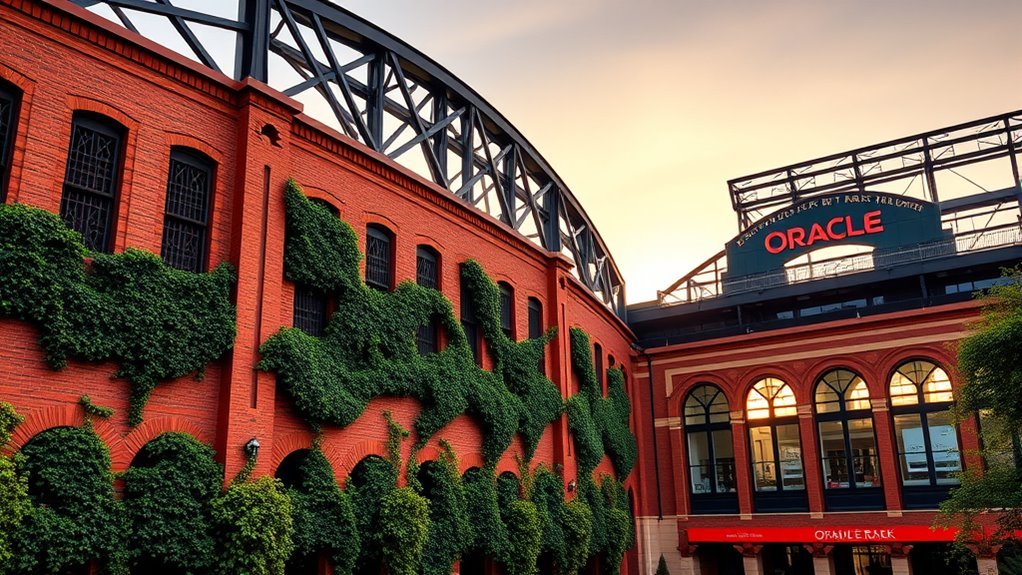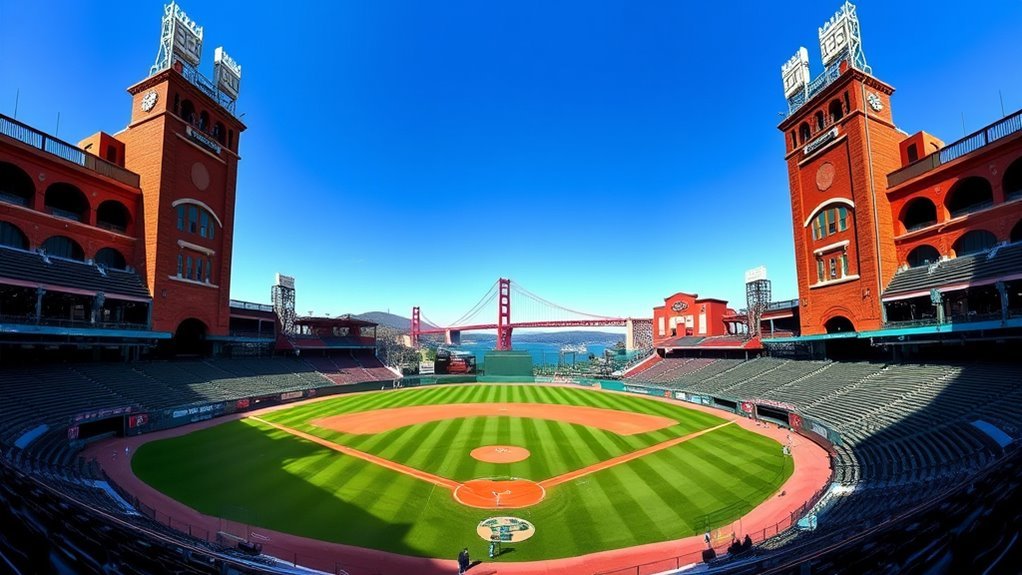You’ve likely heard of Oracle Park, the iconic home of the San Francisco Giants. Its story begins in 1997, when plans for a new ballpark took shape. Opening its gates in 2000, it quickly became a landmark with its stunning architecture and unforgettable events. Over the years, it’s seen name changes and renovations, yet its legacy only grows. Curious about its transformations and historic moments? There’s much more to discover.
Key Takeaways
- Oracle Park opened in 2000 as the first privately financed MLB ballpark since 1962.
- It was initially named Pacific Bell Park, evolving to Oracle Park in 2019.
- Peter Magowan’s leadership was crucial for the development and survival of the Giants.
- It hosted significant baseball milestones, including Barry Bonds’ 756th home run.
- Renovations in 2019-2020 improved fan and player experiences, with plans for ongoing enhancements.
Origins and Early Development

Although the San Francisco Giants had long called Candlestick Park home, the need for a new stadium became apparent by the mid-1970s due to unfavorable conditions at the old venue.
By the mid-1970s, Candlestick Park’s unfavorable conditions highlighted the need for a new stadium for the Giants.
The quest for a new home culminated when Peter Magowan purchased the Giants in 1993, solidifying their presence in San Francisco and jumpstarting plans for Oracle Park. Groundbreaking occurred on December 11, 1997, at the China Basin area.
This project was notable for being the first privately financed Major League Baseball ballpark since Dodger Stadium. Originally named Pacific Bell Park, it underwent several name changes over the years due to evolving naming rights agreements, finally becoming Oracle Park in January 2019.
The Giants’ new home opened on April 11, 2000.
Construction Milestones
The construction of Oracle Park marked a significant architectural achievement in Major League Baseball history.
Located in the China Basin area of San Francisco, groundbreaking for the San Francisco Giants‘ new home took place on December 11, 1997. This ambitious project was notable for being the first privately financed MLB ballpark since 1962, with a construction cost totaling $357 million.
Initially designed to seat 42,000, modifications were made before completion, resulting in a final capacity of about 40,260. The park officially opened on April 11, 2000.
Between October 2019 and June 2020, significant renovations enhanced player safety by relocating the bullpens and adjusting the center field dimensions.
Oracle Park continues to stand as a symbol of innovation and strategic planning.
Financing and Ownership

Having explored the remarkable construction milestones of Oracle Park, let’s now focus on the financial ingenuity and ownership that brought this iconic stadium to life.
Oracle Park stands out as the first privately financed ballpark in Major League Baseball since 1962. Spearheaded by Peter Magowan, this financial marvel combined $100 million from naming rights and sponsorships, a hefty $170 million bank loan, $72 million from selling 16,000 charter seats, and $15 million in tax increment financing.
Magowan’s leadership not only saved the San Francisco Giants franchise but also guaranteed the stadium’s successful realization.
Ownership of Oracle Park rests with the China Basin Baseball Corporation, which manages the venue’s operations, solidifying its role as a cornerstone of San Francisco’s sporting landscape.
Naming Rights Evolution
Since its inception, Oracle Park has undergone several name changes that reflect the evolving landscape of corporate sponsorships in sports.
You might remember it first opened as Pacific Bell Park in 2000, thanks to a $50 million naming rights deal signed in 1996. Just a few years later, in 2004, it became SBC Park when SBC Communications acquired Pacific Bell.
The transformation continued in 2006, as the merger of SBC Communications and AT&T Corporation led to the name AT&T Park.
Fast forward to January 2019, and Oracle Corporation stepped in, purchasing the naming rights and bestowing the title Oracle Park. This 20-year deal guarantees the stadium will be known as Oracle Park, anchoring its identity for years to come.
Architectural Design and Features

Inspired by the timeless charm of iconic venues like Wrigley Field and Fenway Park, Oracle Park’s architectural design captures a nostalgic atmosphere that draws fans into a classic urban ballpark experience.
You’ll find architectural elements like turn-of-the-century lamps and framed antique baseball gloves that enhance the park’s historical ambiance. The sidewalk bricks, shaped like a home plate, add to the charm and authenticity of the environment.
The high-quality playing surface, made from a Kentucky Bluegrass Blend with crushed volcanic rock infield, guarantees first-rate conditions for the San Francisco Giants.
Oracle Park’s varying outfield fence heights, ranging from 8 to 25 feet, present unique challenges for hitters. These features, combined with the field’s pitcher-friendly dimensions, make Oracle Park a standout in Major League Baseball.
Renovations and Upgrades
You’re about to explore the exciting changes Oracle Park has undergone in recent years.
Between relocating the bullpens to enhance player safety and adjusting the field dimensions, these upgrades have transformed the game’s dynamics.
Plus, with the installation of cutting-edge LED lighting and enhanced audio systems, the park now offers an even more immersive experience for fans.
Bullpen Relocation Changes
Following the 2019 season, Oracle Park underwent significant renovations to enhance player safety and improve game dynamics by relocating the bullpens.
The bullpens were moved from foul territory to center field, changing the park’s dimensions and boosting strategic gameplay. This relocation reduced the left-center field from 404 feet to 399 feet and the right-center from 421 feet to 415 feet. Additionally, the height of the center field wall increased from seven feet to ten feet, improving visibility for everyone.
To accommodate the new bullpens, approximately 650 bleacher seats were removed, paving the way for additional terraces.
These changes not only improved player safety but also offered fans a unique viewing experience, making the park more engaging and modern.
Center Field Modifications
After the bullpen relocation, attention shifted to the center field modifications, marking a new era for Oracle Park.
Between October 2019 and June 2020, significant renovations transformed the center field area. You’ll notice changes in the dimensions: left-center now spans 399 feet, right-center 415 feet, and dead-center 391 feet.
These adjustments were designed to enhance player safety and improve the fan experience. By increasing the center field wall height from seven to ten feet, the park improved visibility for spectators.
Approximately 650 bleacher seats were removed to introduce new terraces, offering fans a more engaging view of the action.
These thoughtful modifications make Oracle Park a more dynamic and enjoyable venue for everyone involved in the game.
LED Lighting Installation
As Oracle Park continues to embrace cutting-edge technology, its latest renovation during the 2023–24 offseason saw the installation of advanced programmable LED lighting.
This significant technological upgrade makes it the first MLB ballpark to feature moving light capabilities. You’ll notice how the LED lighting transforms the fan experience, providing dynamic visual effects that enhance both games and events.
It’s not just about the visuals; the park also improved its audio system by adding subwoofers, creating an immersive audio environment.
These enhancements reflect Oracle Park’s dedication to modernizing its facilities and maintaining its status as a premier venue.
Memorable Events and Legacy
When you think of Oracle Park’s legacy, Barry Bonds’ record-breaking home runs immediately come to mind, as he surpassed legends like Babe Ruth and Hank Aaron.
You’ll also remember the electric atmosphere during the Giants’ World Series wins in 2010, 2012, and 2014, solidifying their dominance.
Beyond baseball, the park’s versatility shines with events like the 2007 All-Star Game, making it a cornerstone of San Francisco’s vibrant sports community.
Barry Bonds’ Historic Home Runs
Though many moments define the history of Oracle Park, few are as unforgettable as Barry Bonds’ historic home runs. As a Major League Baseball powerhouse, Bonds achieved remarkable milestones, prominently at this iconic venue.
On May 28, 2006, he hit his 715th career home run at Oracle Park, surpassing Babe Ruth on the all-time list. A year later, on August 7, 2007, Bonds made history again by hitting his 756th home run, breaking Hank Aaron’s revered record.
These achievements contributed considerably to Oracle Park’s legacy, marking it as a pivotal location for baseball milestones. Bonds ended his career in 2007 with a record 762 home runs, solidifying the park’s status as a landmark in MLB history.
Giants’ Championship Triumphs
Oracle Park has become synonymous with the San Francisco Giants‘ championship triumphs, hosting unforgettable victories that define the team’s legacy.
In Giants history, the park witnessed the 2010 World Series win, the first championship in San Francisco since relocating from New York. The 2012 season saw a remarkable comeback as the Giants, after losing the first two games at home, swept the Detroit Tigers.
Then came the 2014 World Series, where the Giants clinched their third title in five years, defeating the Kansas City Royals in a thrilling seven-game series. Each triumph further cemented Oracle Park‘s status in baseball lore.
Legendary moments also include Barry Bonds’ 715th and 756th home runs, sending balls into McCovey Cove, adding to the park’s storied legacy.
Iconic Non-Baseball Events
Amidst its baseball fame, Oracle Park has also carved out a rich history of hosting iconic non-baseball events that capture fans’ imaginations.
In 2006, you would’ve witnessed the U.S. Men’s National Team‘s thrilling 3-2 victory over Japan during a memorable friendly match.
The excitement continued in 2013 with the International Champions Cup featuring a dramatic penalty shootout between Everton and Juventus.
Fast forward to 2022, where Real Madrid and Club América delivered a fascinating 2-2 draw.
In 2023, the La Liga Summer Tour featured matches with Sevilla FC, Atlético de Madrid, Real Betis, and Real Sociedad, enriching the venue’s event diversity.
Looking ahead, the introduction of Bay FC in 2024 marks Oracle Park’s embrace of women’s professional soccer.
Conclusion
You’ve journeyed through Oracle Park’s rich history, from its origins and construction milestones to its evolving name and architectural wonders. You’ve seen how financing and ownership shaped its path and how renovations keep it at the forefront of sports venues. Remember the legendary events and the park’s lasting legacy, including Barry Bonds’ iconic home runs and World Series victories. As Bay FC joins in 2024, Oracle Park is set to continue its tradition of unforgettable moments.
FAQs
1. What Did Oracle Park Used to Be?
You’re curious about Oracle Park’s past. It wasn’t always a stadium; before its construction, the area was part of the industrial China Basin. The transformation into a ballpark marked a significant change for San Francisco.
2. What Are Some Fun Facts About Oracle Park?
You’ll love Oracle Park’s unique features, such as the giant Coca-Cola bottle with slides and the oversized baseball glove. The park’s stunning views and pitcher-friendly design make it a must-visit for any baseball enthusiast.
3. What Is the History of the Giants Stadium?
You’re curious about the Giants’ stadium history? They moved from Candlestick Park to Oracle Park in 2000. Originally Pacific Bell Park, it was the first privately financed MLB park since 1962, costing $357 million.
4. When Did Candlestick Park Become Oracle Park?
Candlestick Park didn’t become Oracle Park. The Giants moved from Candlestick Park to Oracle Park, which opened on April 11, 2000. You’re seeing a separate, privately financed stadium in the vibrant China Basin area.

